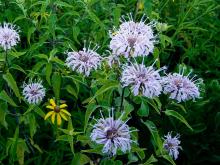Wildflowers, Grasses and Other Nonwoody Plants
Media

Species Types
Scientific Name
Physostegia virginiana
Description
False dragonhead is called "obedient plant" because when you push one of the flowers sideways, it "obediently" stays in place for a while.
Media

Species Types
Scientific Name
Blephilia ciliata
Description
Square, unbranching stems, opposite leaves, two-lipped flowers, and a mild minty fragrance are clues Ohio horsemint is in the mint family. Tight, rounded flower clusters are stacked atop one another at the stem tips.
Media

Species Types
Scientific Name
Monarda bradburiana (sometimes M. russeliana)
Description
Also called horsemint and wild bergamot, Bradbury beebalm is a showy, fragrant plant that is a favorite of native plant gardeners. It’s also a favorite of Missouri’s butterflies!
Media

Species Types
Scientific Name
Teucrium canadense
Description
Like most other mints, American germander has square stems, opposite leaves, and two-lobed flowers. The unusual configuration of the corolla lobes is the key identifying characteristic.
Media

Species Types
Scientific Name
Monarda fistulosa
Description
Sometimes called beebalm, wild bergamot (or horsemint) is a native mint with a long history as a valued Missouri herb. Some people make tea from it, but most of us enjoy its large, colorful flowers.
See Also
About Wildflowers, Grasses and Other Nonwoody Plants in Missouri
A very simple way of thinking about the green world is to divide the vascular plants into two groups: woody and nonwoody (or herbaceous). But this is an artificial division; many plant families include some species that are woody and some that are not. The diversity of nonwoody vascular plants is staggering! Think of all the ferns, grasses, sedges, lilies, peas, sunflowers, nightshades, milkweeds, mustards, mints, and mallows — weeds and wildflowers — and many more!





















